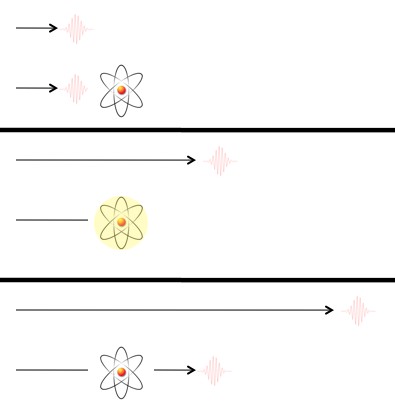Physicist: This bothers a lot of people. When you’re learning physics, there are several things that you learn in the first couple years. Among them are:
1) The speed of light is an absolute.
2) Light slows down when it passes through a medium (like water, glass, air, …).
The first statement is the backbone of all of modern physics (relativity), and the second helps explain things like diffraction and rainbows. But clearly these statements contradict each other.
Here’s the idea: a medium, whatever it is, is made up of molecules. When a photon (light particle) hits a molecule it is sometimes absorbed. Its energy is turned into raised electron-energy-levels, or vibrations and flexing, or movement. In short order (very short order) the photon is spit out of the other side, none the worse for wear.

When a photon hits a molecule it's sometimes absorbed and re-emitted. That process takes a little bit of time that we interpret as a "slowing".
In between molecules light still travels at light speed. It’s just that, with all those molecules around, it’s always darting ahead, getting absorbed, pausing for a moment, then being re-emitted. On the scale we’re used too, this happens so much and so fast that you don’t notice the starting-and-stopping. Instead you notice an average slowing of the light.
That is, if light always takes about 33% longer to travel through water than air (and it does) due to absorption and re-emission, you’d say “ah, light travels slower through water!”. The fact that that isn’t quite the case is rarely important.
Answer gravy: This isn’t part of the answer, but it’s interesting: The interaction between light and the medium it moves through is generally “clean”, in the sense that even if the light is in a complicated quantum state before entering the medium, it retains it. As a result, light continues to point in the same direction (which is good, in terms of seeing stuff), and even keeps its polarization.
What’s really fascinating, is that even more bizarre quantum states, like those involving being spread out over a large area, are also allowed to persist. If this were not the case it would be impossible to do the double slit experiment (which requires the photon to be in many locations) without a specially prepared vacuum chamber!







78 Responses to Q: If light slows down in different materials, then how can it be a universal speed?